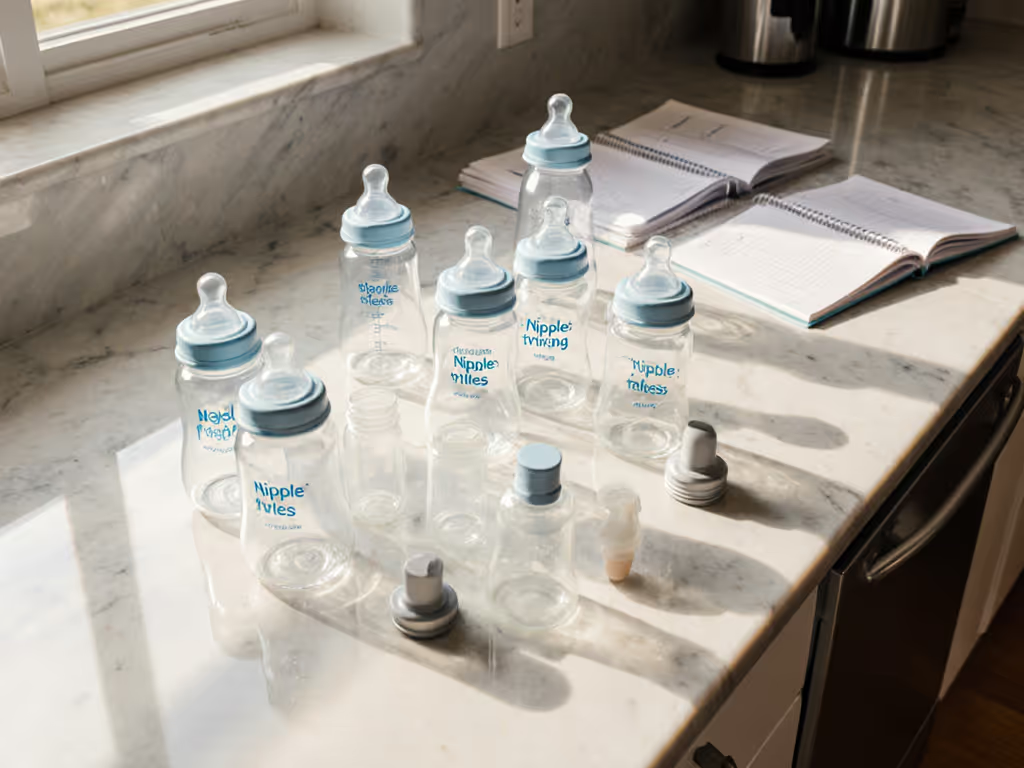
7 Common Bottle Feeding Mistakes Parents Should Avoid

Over 60 percent of new parents make at least one bottle feeding mistake without realizing it. The smallest missteps can turn a peaceful mealtime into a stressful experience for both you and your baby. Knowing what to avoid and how to spot common problems makes bottle feeding smoother, safer, and more comfortable for your little one. Get ready to learn the key bottle feeding mistakes most parents don’t see coming and how a few simple changes create happier feeding sessions.
Quick Summary
| Takeaway | Explanation |
|---|---|
| 1. Choose the Right Nipple Flow | Select nipple flows that match your baby's stage to prevent choking or frustration during feeds. |
| 2. Use Proper Bottle Positioning | Hold the bottle in a horizontal position to control milk flow and mimic breastfeeding. |
| 3. Don't Skip Burping Breaks | Incorporate regular burping during and after feeds to reduce discomfort from swallowed air. |
| 4. Ensure Bottle Sterilization | Thoroughly clean and sterilize bottles to prevent harmful bacteria and protect your baby's health. |
| 5. Observe Hunger and Fullness Cues | Pay attention to your baby's subtle signals to prevent overfeeding or underfeeding during meals. |
1. Using the Wrong Nipple Flow for Your Baby
Choosing the correct nipple flow is far more critical than most parents realize. Each baby has unique feeding needs, and selecting an inappropriate nipple flow can lead to frustrating feeding sessions and potential discomfort.
Nipple flow refers to the rate at which milk or formula passes through the nipple opening. Babies at different ages and stages of development require specific flow rates that match their sucking strength and swallowing abilities. Using a nipple flow that is too fast or too slow can create multiple challenges.
With a flow that is too fast, babies might struggle to manage the rapid milk stream. This can cause choking, coughing, and overwhelming feeding experiences. Alternatively, a nipple flow that is too slow can frustrate your baby, leading to excessive sucking effort and potential exhaustion during feeds.
How to Match the Right Nipple Flow
To select the appropriate nipple flow, consider these key factors:
- Newborns (0-3 months): Require slow flow nipples that mimic breastfeeding
- 3-6 months: Gradually transition to slightly faster flow nipples
- 6+ months: Use medium to fast flow nipples as babies develop stronger sucking abilities
Watch your baby closely during feeding. Signs of incorrect nipple flow include:
- Consistent spluttering or choking
- Pulling away from the bottle frequently
- Taking longer than 20 minutes to complete a feed
- Showing signs of frustration or exhaustion
Pro Parent Tip: Most bottle brands offer multiple nipple flow options. Always test and observe how your baby responds to different flows, and be prepared to make adjustments as they grow.
2. Incorrect Bottle Angle During Feeding Sessions
Bottle feeding might seem straightforward, but the angle at which you hold the bottle can dramatically impact your baby's feeding experience and comfort. Bottle positioning is more than just getting milk into your baby's mouth it is about creating a safe, efficient feeding environment.
When you hold a bottle incorrectly, several potential problems can emerge. Improper angles can cause air ingestion, leading to uncomfortable gas buildup, excessive spit up, and potential feeding frustration. The Cleveland Clinic highlights the importance of paced bottle feeding, which involves holding the bottle horizontally and keeping the baby in a semi upright position.
Paced bottle feeding mimics breastfeeding mechanics by allowing your baby to control milk flow and pace. This technique helps prevent overfeeding and reduces the risk of nipple confusion. The key is to position the bottle so that milk fills only the nipple tip, preventing your baby from being overwhelmed by a constant milk stream.
Proper Bottle Positioning Techniques
To master bottle feeding angle, follow these strategic steps:
- Keep the bottle horizontal to slow milk flow
- Support your baby in a semi upright position
- Tilt the bottle just enough to keep the nipple and neck filled with milk
- Allow brief pauses during feeding to mimic natural breastfeeding rhythm
Pro Parent Tip: Watch your baby closely. If they seem uncomfortable, struggle to swallow, or appear overwhelmed, adjust your bottle angle and feeding pace. Each baby is unique and may require slight modifications to find their perfect feeding position.
3. Skipping Regular Burping Breaks
Burping might seem like a simple task, but it plays a crucial role in your baby's feeding comfort and digestive health. Overlooking regular burping breaks can transform what should be a peaceful feeding session into a challenging experience for both baby and parent.
During feeding, babies naturally swallow air along with milk or formula. This trapped air can create significant discomfort, leading to gas, bloating, and potential colic symptoms. Research from the University of Nevada highlights that consistent burping helps release swallowed air, preventing digestive distress and promoting a more comfortable feeding experience.
Effective burping is about timing and technique. Babies need burping breaks not just after feeding, but also during their meal. By interrupting feeding sessions with gentle burping, you help your little one manage air intake and reduce the likelihood of painful gas buildup.
Burping Techniques for Different Feeding Positions
Try these burping methods to support your baby's comfort:
- Over the shoulder method: Hold baby upright against your chest
- Sitting on lap method: Support baby's chest and head while gently patting their back
- Lying across lap method: Place baby face down across your legs with their head slightly elevated
Pro Parent Tip: Every baby is different. Some might need frequent burping, while others require less intervention. Pay attention to your baby's signals like squirming, fussiness, or pulling away during feeding as indicators that they might need a burping break.
4. Overlooking Bottle and Nipple Sterilization
Bottle feeding requires more than just mixing formula or pouring milk. Proper sterilization is a critical step that protects your baby from harmful bacteria and potential health risks. Many parents underestimate the importance of thorough cleaning and sanitizing feeding equipment.
Babies have delicate immune systems that are particularly vulnerable to bacterial infections. Unclean bottles and nipples can become breeding grounds for microorganisms that might cause digestive issues, infections, or more serious health complications. The University of Nevada recommends comprehensive cleaning protocols to ensure your baby's feeding tools remain safe and hygienic.
Effective sterilization goes beyond a quick rinse under water. It involves a systematic approach to cleaning that eliminates potential pathogens and ensures each feeding experience is as safe as possible. Warm soapy water, thorough rinsing, and proper air drying are fundamental steps in maintaining bottle hygiene.
Comprehensive Bottle Cleaning Strategy
Implement these critical sterilization steps:
- Disassemble all bottle components before washing
- Use hot water and specialized baby bottle soap
- Scrub thoroughly with a clean bottle brush
- Rinse multiple times with clean water
- Allow components to air dry on a clean towel
Pro Parent Tip: Consider having multiple bottle sets to rotate during cleaning. This ensures you always have a clean bottle ready and reduces the stress of constant immediate washing. For newborns, sterilizing after every use provides an extra layer of protection against potential infections.
5. Feeding Baby While Lying Flat
Feeding a baby in a completely horizontal position might seem convenient, but it can create significant feeding challenges and potential health risks. Lying flat during bottle feeding is far from the optimal positioning that supports safe and comfortable nutrition.
The Cleveland Clinic emphasizes that feeding position directly impacts milk flow, swallowing mechanics, and overall feeding safety. When babies are fed while lying completely flat, several problematic scenarios can emerge. Milk can pool in their mouth, increasing choking risks and potentially causing ear infections through improper drainage.
Proper feeding positioning mimics the natural breastfeeding posture, which inherently supports safer milk transfer. A semi upright position allows gravity to assist in controlled milk flow, enables better swallowing, and reduces the likelihood of uncomfortable air ingestion.
Recommended Feeding Positioning Techniques
To ensure safe and comfortable feeding, practice these positioning strategies:
- Maintain a 45 degree angle when holding your baby
- Support your baby's head and neck
- Keep the bottle horizontal to control milk flow
- Ensure your baby's head is slightly higher than their body
Pro Parent Tip: Think of feeding time as a bonding experience. By holding your baby in a semi upright position, you not only enhance safety but also create an opportunity for eye contact and emotional connection during feeding.
6. Switching Bottles or Nipples Too Frequently
Changing bottles and nipples might seem like a simple solution to feeding challenges, but it can create unexpected complications for your baby. Constant switching disrupts your baby's feeding rhythm and can lead to significant feeding difficulties.
The Cleveland Clinic warns that frequent changes in feeding equipment can trigger nipple confusion a problematic condition where babies struggle to adapt between different bottle and nipple types. Babies develop specific sucking patterns and muscle memory during feeding, and abrupt changes can create stress and inefficient nutrition.
Consistency is key in creating a comfortable feeding experience. When babies become familiar with a specific bottle and nipple design, they develop more efficient feeding techniques. Repeatedly introducing new equipment forces them to relearn their feeding mechanics, which can result in frustration, reduced milk intake, and potential feeding resistance.
Strategies for Minimizing Bottle and Nipple Disruption
Consider these guidelines for maintaining feeding consistency:
- Choose one bottle system and stick with it initially
- Introduce changes gradually if absolutely necessary
- Observe your baby's reaction to any new feeding equipment
- Consult with pediatric professionals before making significant changes
Pro Parent Tip: If you must switch bottles or nipples, do so incrementally. Introduce the new item alongside the familiar one, allowing your baby to adjust at their own pace and comfort level.
7. Ignoring Baby's Hunger and Fullness Cues
Feeding is more than just providing nutrition it is a delicate communication between you and your baby. Understanding and responding to your baby's subtle hunger and fullness signals can transform feeding from a routine task into a responsive, nurturing experience.
Babies communicate their feeding needs through a complex language of physical and behavioral cues. Misreading or completely missing these signals can lead to overfeeding, underfeeding, and unnecessary feeding stress. Each baby has a unique communication style that requires attentive and patient interpretation.
Recognizing hunger signals goes beyond crying, which is often a late stage indicator of extreme hunger. Early hunger cues are much more nuanced and include specific body movements, facial expressions, and subtle behavioral changes that parents can learn to identify.
Decoding Your Baby's Feeding Communication
Learn to recognize these key hunger and fullness indicators:
- Hunger Signals: Rooting, lip smacking, hand sucking, turning head toward breast or bottle
- Early Hunger Cues: Increased alertness, mouth opening, tongue movement
- Fullness Indicators: Turning away, closing mouth, slowing down sucking
- Satiation Signs: Relaxed body, releasing bottle or breast, losing interest in feeding
Pro Parent Tip: Practice observation during feeding sessions. Each feeding is an opportunity to understand your baby's unique communication style. Responsive feeding builds trust and helps establish healthy eating patterns from the earliest stages of life.
Below is a comprehensive table summarizing the key parenting strategies and recommendations discussed throughout the article on optimal baby feeding techniques.
| Topic | Description | Key Considerations |
|---|---|---|
| Nipple Flow | Selecting the appropriate nipple flow is critical to match the baby's developmental stage. | Watch for signs like spluttering or frustration; adjust as the baby grows. |
| Bottle Angle | Proper bottle positioning prevents air ingestion and ensures efficient feeding. | Use paced feeding by holding the bottle horizontally with the baby semi-upright. |
| Burping Breaks | Regular burping prevents gas buildup and discomfort. | Implement mid-feeding burps using various techniques based on baby's position. |
| Sterilization | Thorough cleaning of bottles prevents harmful bacteria exposure. | Disassemble bottles, use hot water and baby soap, and air dry. |
| Feeding Position | A semi-upright position during feeding supports better milk flow and reduces health risks. | Avoid flat feeding to minimize choking and ear infection risks. |
| Consistency with Equipment | Frequent changes in bottles or nipples disrupt feeding rhythm. | Gradually introduce new equipment; observe baby’s adaptation. |
| Interpreting Baby Cues | Understanding hunger and fullness cues enhances feeding experience. | Recognize early signs like rooting and fullness indicators like slowing down sucking. |
Avoid Common Bottle Feeding Mistakes with Expert Guidance
Feeding your baby should be a joyful and stress-free experience but choosing the wrong nipple flow or holding the bottle at an improper angle can quickly turn feeding time into a challenge. The article highlights real frustrations like choking, gas buildup, and feeding refusal that many parents face when common mistakes slip in. If you want to feel confident matching the right nipple flow, mastering bottle positioning, and understanding your baby’s hunger cues then personalized support makes all the difference.
At Family Bottle Fit, we specialize in helping parents navigate these exact feeding challenges. Our detailed guides and practical tools empower you to customize bottle components like nipples and vents to fit your baby’s unique needs reducing nipple confusion and feeding stress. Don’t let guesswork take over feeding time. Discover easy data-driven methods and at-home checks to create calmer, safer, and more effective feeding sessions right now. Explore our resources and start improving your baby’s feeding experience today at Family Bottle Fit and see how simple changes lead to happier mealtimes.
Frequently Asked Questions
What are the common signs of using the wrong nipple flow when bottle feeding?
Using the wrong nipple flow can lead to choking, excessive fussiness, or prolonged feeding sessions. Watch for signs like spluttering, pulling away from the bottle, or taking longer than 20 minutes to finish a feed. Adjust the nipple flow based on your baby's responsiveness to ensure a smoother feeding experience.
How can I properly position the bottle during feeding?
To maintain proper bottle positioning, hold the bottle horizontally and keep it tilted just enough so that the nipple is filled with milk. Keeping your baby in a semi-upright position allows them to control the flow, similar to breastfeeding. Prioritize this technique to enhance comfort and safety during feeds.
When should I burp my baby during bottle feeding?
Burp your baby not only at the end of their feeding but also during pauses throughout the meal. This helps release any swallowed air, preventing discomfort from gas. Frequent burping can make feeding more enjoyable and stress-free for both you and your baby.
What steps should I take for effective bottle and nipple sterilization?
For effective sterilization, disassemble all bottle components and wash them with hot, soapy water using a clean bottle brush. Rinse thoroughly and allow them to air dry on a clean towel. Make it a habit to clean bottles after every use to protect your baby from harmful bacteria.
How can I stop my baby from being fed while lying flat?
Avoid feeding your baby in a completely flat position by maintaining a 45-degree angle during feeding. Support their head and neck while holding the bottle horizontally to control milk flow safely. This reduces choking risks and promotes better swallowing mechanics.
What should I do if my baby shows signs of nipple confusion?
If your baby shows signs of nipple confusion, try to limit changes in bottles and nipples to allow them to get accustomed to one particular style. Introduce any new feeding equipment gradually if necessary, watching for their reactions. Keeping feeding consistent can ease the transition and support more effective feeding.
Related Articles


Nipple Flow Rates: Everything You Need to Know

Bottle Compatibility: Everything You Need to Know

Complete Guide to Breast-Like Nipples for Babies

